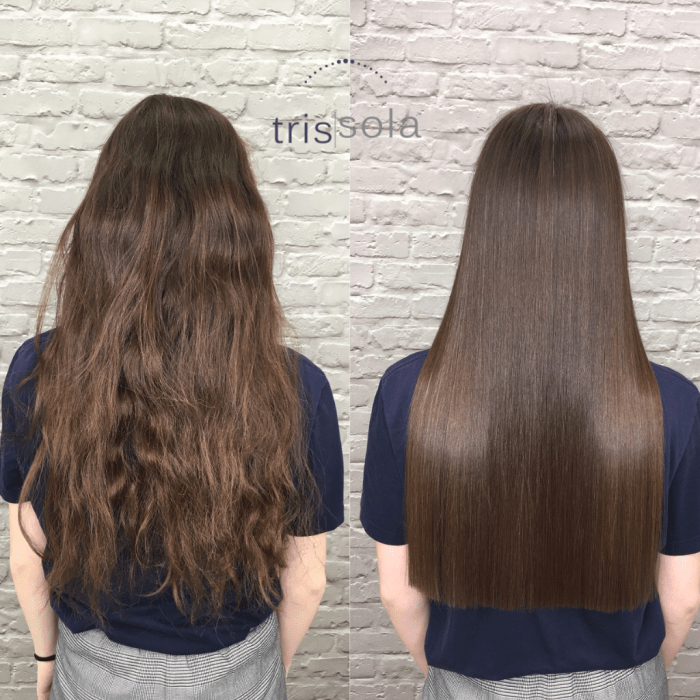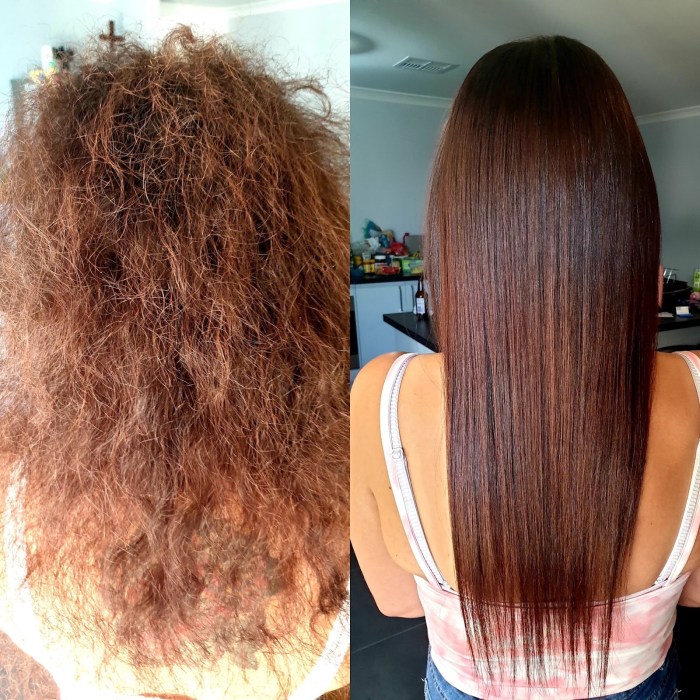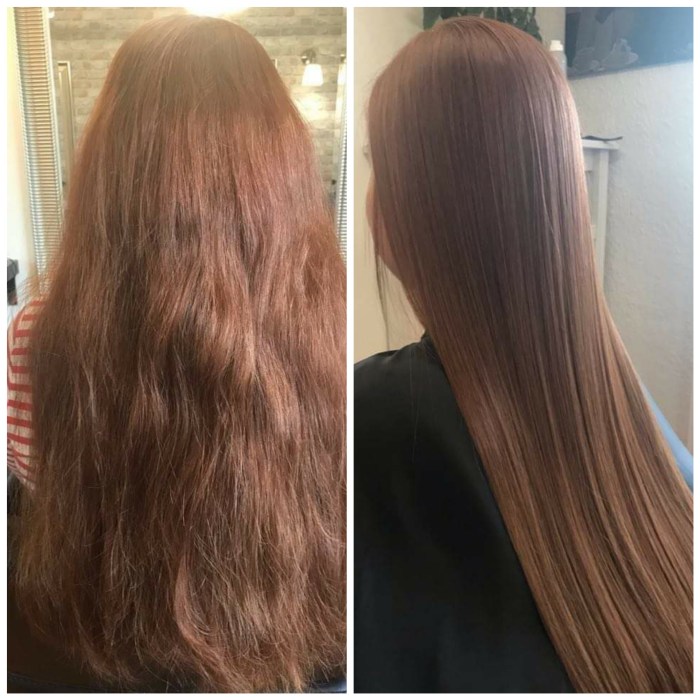Unveiling the wonders of hair keratin, this comprehensive guide will empower you with the knowledge and techniques to revitalize your hair’s health and beauty from the comfort of your own home. Whether you seek to strengthen your strands, smooth out frizz, or restore your hair’s natural radiance, this exploration of home keratin hair treatments will provide you with all the essential information and guidance you need.
From understanding the science behind keratin’s benefits to mastering the step-by-step application process, this guide will equip you with the expertise to achieve salon-quality results at home. Prepare to embark on a transformative journey towards healthier, more manageable, and irresistibly beautiful hair.
Hair Keratin

Hair keratin is a fibrous protein that forms the primary structural component of hair. It is a complex molecule composed of amino acids arranged in a specific sequence, giving hair its unique properties and characteristics.
Keratin provides hair with strength, flexibility, and resistance to damage. It is responsible for the hair’s ability to withstand mechanical stress, such as brushing and styling, and environmental factors, such as heat and UV radiation.
Benefits of Keratin for Hair Health
- Strengthens hair: Keratin helps to reinforce the hair shaft, making it less prone to breakage and split ends.
- Smoothes hair: Keratin fills in damaged areas of the hair shaft, creating a smooth and even surface. This reduces frizz and flyaways, leaving hair looking sleek and polished.
- Reduces frizz: Keratin helps to seal the hair cuticle, preventing moisture from escaping and reducing frizz. This is especially beneficial for hair that is prone to dryness or humidity.
Hair Types that Benefit from Keratin Treatments
Keratin treatments can be beneficial for all hair types, but they are particularly effective for hair that is:
- Damaged: Keratin treatments can help to repair and restore damaged hair, making it stronger and healthier.
- Dry or frizzy: Keratin treatments can help to hydrate and smooth dry or frizzy hair, reducing frizz and flyaways.
- Colored or chemically treated: Keratin treatments can help to protect colored or chemically treated hair from damage and fading.
Home Keratin Hair Treatments
Keratin hair treatments at home offer a convenient and cost-effective way to achieve smooth, frizz-free hair without the need for professional salon services. There are various types of home keratin treatments available, each with its own unique benefits and application methods.
Types of Home Keratin Hair Treatments
- Liquid Keratin Treatments: These treatments are applied directly to the hair and left in for a period of time before being rinsed out. They contain a high concentration of keratin protein, which penetrates the hair shaft and fills in damaged areas, resulting in smoother, more manageable hair.
- Cream Keratin Treatments: Cream keratin treatments are thicker and more concentrated than liquid treatments. They are applied to the hair and left in for a longer period of time, typically overnight. They provide a deeper conditioning effect and can be particularly beneficial for dry, damaged hair.
- Keratin Hair Masks: Keratin hair masks are similar to cream treatments but are designed to be left in for a shorter period of time, typically 30 minutes to an hour. They are a good option for those who want to enjoy the benefits of keratin without committing to a longer treatment time.
Steps Involved in Applying a Home Keratin Hair Treatment
The steps involved in applying a home keratin hair treatment vary depending on the specific product being used. However, the general process typically includes the following steps:
- Preparation: Wash your hair with a clarifying shampoo to remove any dirt or product buildup. Do not condition your hair, as this can interfere with the treatment.
- Application: Apply the keratin treatment to your hair according to the manufacturer’s instructions. Typically, this involves applying the treatment evenly to damp hair and leaving it in for the specified amount of time.
- Rinsing: After the treatment time has elapsed, rinse your hair thoroughly with warm water. Do not use shampoo or conditioner at this stage.
- Drying and Styling: Towel-dry your hair and then blow-dry it straight using a brush. This will help to seal the keratin into the hair shaft and enhance the results of the treatment.
Tips for Choosing the Right Home Keratin Hair Treatment
When choosing a home keratin hair treatment, it is important to consider your hair type and desired results. For fine or damaged hair, a liquid keratin treatment may be a good option as it provides a lighter conditioning effect. For thick or coarse hair, a cream keratin treatment or hair mask may be more suitable as they offer a deeper conditioning and smoothing effect.
It is also important to read the product reviews and ingredients list carefully before making a purchase. This will help you to ensure that the treatment is suitable for your hair type and that it contains high-quality ingredients.
Ingredients and Equipment for Home Keratin Treatments
Home keratin hair treatments require a specific set of ingredients and equipment to achieve optimal results. Understanding the importance and proper usage of these components is crucial for a successful treatment.
Essential Ingredients
* Keratin Solution: The core ingredient, keratin, is a protein naturally found in hair. It fills in damaged areas, strengthens hair strands, and improves overall hair health.
Clarifying Shampoo
This shampoo removes dirt, oil, and product buildup, ensuring the keratin solution penetrates the hair more effectively.
Conditioner
A post-treatment conditioner helps seal the keratin into the hair, enhancing its longevity and shine.
Formaldehyde-Free Solution
Formaldehyde is a common ingredient in keratin treatments, but it can be harmful. Look for formaldehyde-free solutions to minimize potential health risks.
Essential Equipment
* Gloves: Protect your hands from the keratin solution, which can be irritating.
Brush
A wide-toothed brush helps distribute the keratin solution evenly throughout the hair.
Heat Tools
A blow dryer and flat iron are necessary to seal the keratin into the hair.
Hair Clips
Sectioning the hair with clips makes the application process more manageable.
Importance of Quality
Using high-quality ingredients and equipment is crucial for effective home keratin treatments. Inferior products can compromise results, damage hair, or cause skin irritation. Invest in reputable brands and follow the instructions carefully to ensure a safe and successful treatment.
Step-by-Step Guide to Applying a Home Keratin Hair Treatment
Applying a home keratin hair treatment is a straightforward process that can be completed in the comfort of your own home. Follow these steps carefully to achieve optimal results:
Preparation
Before applying the keratin treatment, it is essential to prepare your hair to ensure maximum absorption and effectiveness. Begin by washing your hair with a clarifying shampoo to remove any product buildup or dirt. Avoid using conditioners or styling products, as these can interfere with the treatment’s bonding process.
Once your hair is clean, towel-dry it and brush out any tangles. Divide your hair into manageable sections, using clips to hold them in place. This will make the application process easier.
Application
Wear gloves throughout the application process to protect your skin from the treatment solution. Apply the keratin solution to each section of hair, starting at the roots and working your way down to the tips. Use a brush or comb to distribute the solution evenly and ensure that every strand is coated.
Once the solution has been applied, cover your hair with a plastic cap or wrap it in plastic wrap. This will help create a warm environment that allows the keratin to penetrate the hair shafts more effectively.
Processing Time
The processing time for a home keratin hair treatment typically ranges from 30 to 60 minutes. The specific time will depend on the thickness and texture of your hair. Consult the manufacturer’s instructions for the recommended processing time for your hair type.
During the processing time, it is important to keep your hair covered and avoid touching or manipulating it. This will prevent the keratin from setting prematurely and compromising the treatment’s effectiveness.
Rinsing and Drying
Once the processing time is complete, rinse your hair thoroughly with warm water until the water runs clear. Do not use shampoo or conditioner at this stage.
Towel-dry your hair and blow-dry it on a low heat setting. Avoid using a brush or comb while your hair is still damp, as this can damage the keratin bonds.
Post-Treatment Care
After applying a home keratin hair treatment, it is essential to follow proper post-treatment care instructions to maintain the results and prolong the treatment’s effectiveness.
- Avoid washing your hair for 3 days after the treatment to allow the keratin to fully set and bond to your hair.
- Use sulfate-free shampoos and conditioners to avoid stripping the keratin from your hair.
- Limit the use of heat styling tools, as excessive heat can damage the keratin bonds.
- Protect your hair from the sun and chlorine in swimming pools, as these can also damage the keratin.
Aftercare for Keratin-Treated Hair
Maintaining the health and longevity of your keratin-treated hair requires proper aftercare. This involves using the right products and following specific guidelines to protect the keratin bonds and prevent damage.
After undergoing a keratin treatment, it’s essential to invest in sulfate-free shampoos and conditioners. Sulfates are harsh detergents that can strip away the keratin coating, reducing the treatment’s effectiveness. Instead, opt for gentle, sulfate-free products designed for treated hair.
Styling Products
When styling keratin-treated hair, it’s crucial to avoid products containing alcohol or harsh chemicals. These substances can damage the keratin bonds, causing frizz and dryness. Instead, choose styling products specifically formulated for treated hair, such as heat protectants, leave-in conditioners, and anti-frizz serums.
Washing Frequency
Keratin-treated hair typically requires less frequent washing than untreated hair. Over-washing can strip away natural oils and weaken the keratin bonds. Aim to wash your hair 2-3 times per week, using lukewarm water and gentle, sulfate-free shampoo.
Styling Frequency
Excessive heat styling can damage keratin-treated hair, so it’s important to limit the use of hot tools. Air-drying is the gentlest option, but if you must use heat, apply a heat protectant spray first and use the lowest heat setting possible.
Comparing Home Keratin Treatments to Salon Treatments

Home keratin treatments have gained popularity as an alternative to salon treatments. However, it’s important to understand the differences in effectiveness, advantages, and disadvantages to make an informed decision.
Effectiveness
The effectiveness of home keratin treatments can vary depending on the quality of the products used and the application technique. Salon treatments are generally more effective as they use professional-grade products and are applied by trained stylists. However, home treatments can still provide noticeable results, especially if done correctly and with high-quality products.
Advantages and Disadvantages
Home Treatments Advantages:
- Convenient and can be done at home
- More affordable than salon treatments
- Can be customized to individual needs
Disadvantages:
- May not be as effective as salon treatments
- Requires careful application and can be time-consuming
- Results may vary depending on hair type and condition
Salon Treatments Advantages:
- Highly effective and provides professional results
- Performed by trained stylists ensuring proper application
- Consistent and predictable outcomes
Disadvantages:
- More expensive than home treatments
- Requires scheduling an appointment and travel
- May involve additional costs for maintenance and touch-ups
Choosing the Best Option
The best option for keratin treatment depends on individual needs and preferences. For those seeking professional-grade results and are willing to invest, salon treatments are a better choice. For those on a budget or prefer convenience, home treatments can be a suitable option.
It’s important to research products and techniques thoroughly and follow instructions carefully for optimal results.
Last Word

As you delve into the world of home keratin hair treatments, remember that knowledge is power. Embrace the insights provided in this guide to make informed choices, care for your keratin-treated hair with diligence, and witness the remarkable transformation of your locks.
Let your hair radiate with newfound vitality, smoothness, and an irresistible shine, all achieved through the empowering knowledge you have gained.
FAQ Section
What are the key benefits of keratin treatments for hair?
Keratin treatments offer a multitude of benefits for hair, including strengthening and repairing damaged strands, reducing frizz and enhancing smoothness, protecting against heat and environmental stressors, and promoting overall hair health and vitality.
How often should I apply a home keratin hair treatment?
The frequency of home keratin treatments depends on your hair type and desired results. For optimal maintenance, treatments can be applied every 2-3 months to replenish keratin levels and maintain healthy, manageable hair.
Can I use any type of shampoo and conditioner after a keratin treatment?
To preserve the longevity and effectiveness of your keratin treatment, it is essential to use sulfate-free shampoo and conditioner. These products are designed to gently cleanse and condition without stripping away the keratin proteins.



